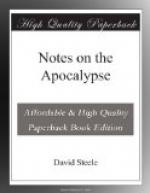CHAPTER XXII.
1. And he showed me a pure river of water of life, clear as crystal, proceeding out of the throne of God and of the Lamb.
2. In the midst of the street of it, and on either side of the river, was there the tree of life, which bare twelve manner of fruits, and yielded her fruit every month: and the leaves of the tree were for the healing of the nations.
3. And there shall be no more curse: but the throne of God and of the Lamb shall be in it; and his servants shall serve him.
4. And they shall see his face; and his name shall be in their foreheads.
5. And there shall be no night there: and they need no candle, neither light of the sun: for the Lord God giveth them light: and they shall reign for ever and ever.
Vs. 1-5.—These verses, being a continuance of the description of the “holy city,” naturally belong to the preceding chapter.—The angel proceeds to show John the source and current from which emanate all heavenly blessings. The allusion is to Ezekiel, xlvii. 1-12; but both he and John call our attention to man’s primeval state, when our first parents dwelt in Eden. This abode of the blessed is beautified and enriched with all the products, delights and attractions which are adapted to the refined senses of holy creatures,—“pleasant to the eyes, and good for food.” It is Paradise restored, by the “doing and dying” of the second Adam. It is also Paradise improved, having not only the “tree of life,” as the first had, but also, in addition, the “water of life.” The “tree of life” was to sinless Adam a symbol and pledge of immortality to himself and all his posterity whom he represented in the Covenant of Works. Now that heaven is procured for all believers by the second Adam, it is emblematically represented to our weak apprehension by directing our attention to the primitive and earthly Paradise. This is repeatedly done in Scripture. The Lord Jesus, before he expired upon the cross, said to the penitent thief,—“To day shall thou be with me in Paradise. (Luke xxiii. 43.) Paul was “caught up” thither, (2 Cor. xii. 4;) and he calls the place “heaven,” (v. 2;) and in this book, (ch. ii. 7,) the Lord promises,—“I will give to him that overcometh to eat of the tree of life, which is in the midst of the paradise of God.” The “tree” is an emblem of Christ, (Song ii. 3;) the “river of the water of life” symbolizes the Holy Spirit, (John vii. 38, 39;) for as the Son and the Holy Ghost proceed from the Father, the former by generation, the latter by emanation from eternity,—so “that eternal life which was with the Father” in the person of the Son, and purchased by the Son, is communicated by the Holy Ghost to all the redeemed by regeneration. (2 Cor. iii. 6; Rom. viii. 2.)—Thus, the eternal duration of life in glory “proceeds out of the throne of God and the Lamb.” On each side of the river “the tree of life”




